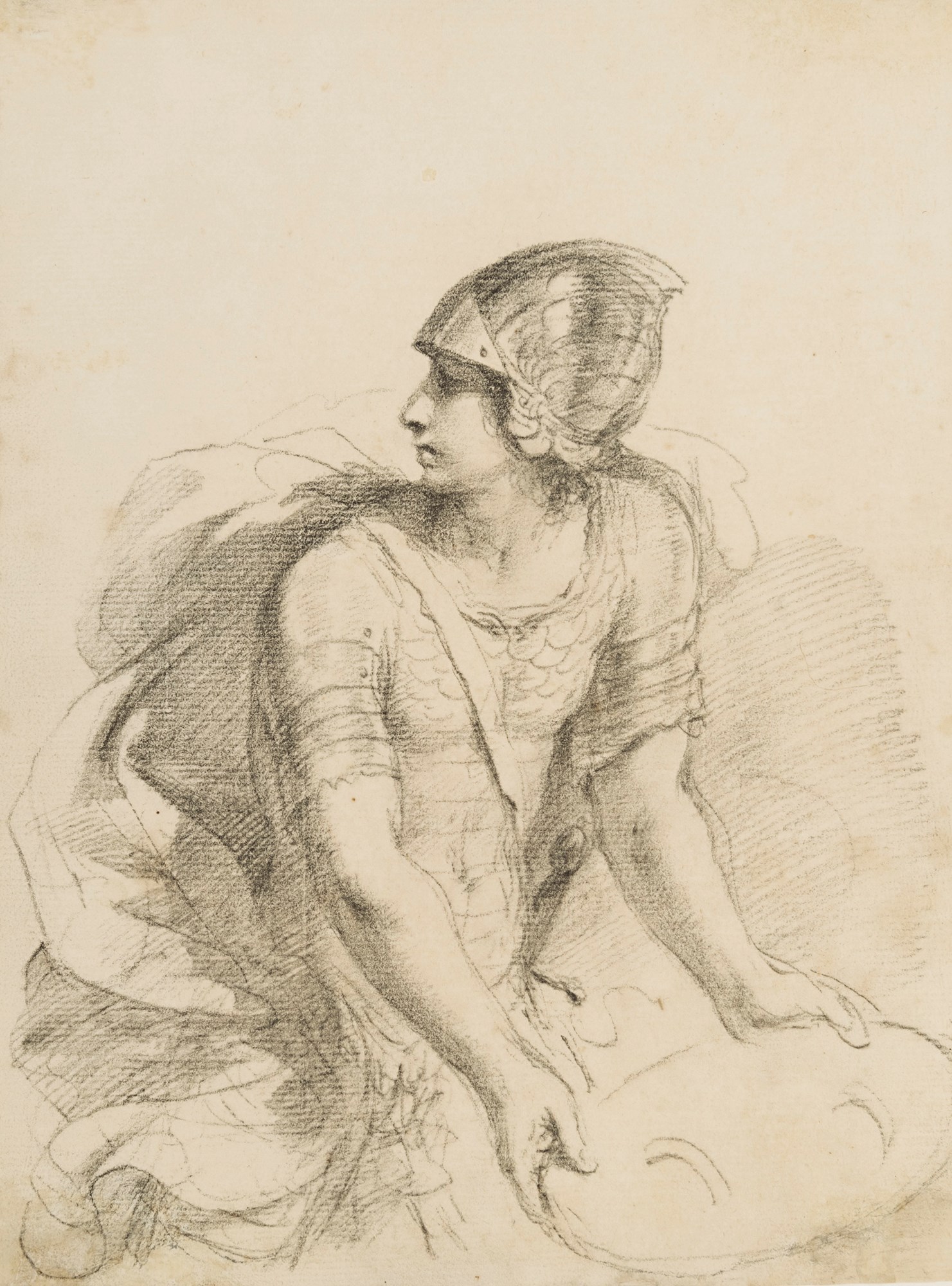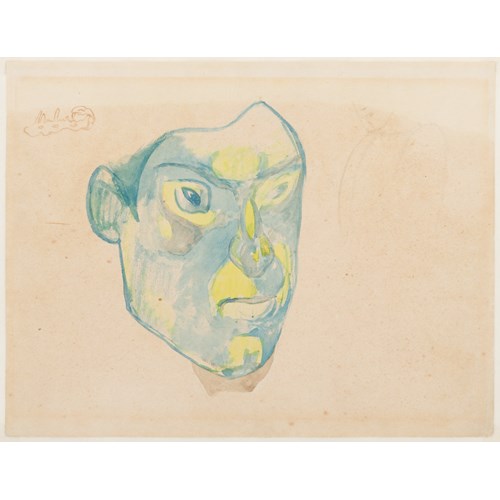Marketplace
A Soldier in Armour Facing Right, Holding a Shield and Looking to the Left
Giovanni Francesco Barbieri GUERCINO
A Soldier in Armour Facing Right, Holding a Shield and Looking to the Left
It has been noted, by Nicholas Turner and Carol Plazzotta, that ‘Guercino seems to have used black chalk only rarely, especially in the later part of his career, even though he achieved effects of great delicacy with the medium.’ Although, as Turner has further pointed out, ‘Guercino did not often use the technique of black chalk for his figures’, such drawings in black chalk as exist tend to be found more among the artist’s preparatory studies for paintings of the 1640s than in previous decades.
This splendid drawing – recently described by David Stone as ‘a delicate sketch in black chalk of a soldier, looking left but moving towards the right…a stunning drawing from Guercino’s mature period, fully consonant with drawings and paintings of the 1640s’ – has been related by Stone to Guercino’s large canvas of Hersilia Intervening Between Romulus and Tatius (or The Sabine Women Intervening to Bring Peace Between the Romans and the Sabines), painted in 1645 for the Parisian collector Louis Phélypeaux de La Vrillière and now in the Louvre. The drawing would appear to represent an early and unused idea for the pose of the striding warrior – usually identified as Titus Tatius, King of the Sabines - at the left of the composition, although in the final painting this figure is shown with a short beard. While the youthful appearance of the figure in the present sheet would seem to argue against it being a study for the bearded and apparently slightly older warrior in the painting, it would not be unusual for Guercino to experiment with different ideas for the facial appearance of this figure. Indeed, another preparatory drawing that can be definitively related to the Louvre canvas - a pen and ink sheet in a private American collection - depicts several profile studies of the head of the same warrior, some of which show him unbearded.
The warrior in this drawing, wearing armour and a helmet akin to that of the equivalent figure in the Louvre painting, and holding a similar oval shield, looks behind him, and seems to be in the act of placing his shield on the ground. It is conceivable, therefore, that when planning the composition Guercino had initially considered having the Sabine princess Hersilia approach Tatius from the left to beseech him to lay down his arms, and to show him beginning to lower his shield. In the end, however, Guercino chose to depict the more dramatic episode of the combat between the Sabine king Tatius and his Roman challenger Romulus about to commence, before the truce brought about by Hersilia’s mediation.
The present sheet can be likened to another drawing in black chalk that has also been related to the painting of Hersilia Intervening Between Romulus and Tatius of 1645; a head of a helmeted warrior, similarly youthful and unbearded, in the collection of the Teyler Museum in Haarlem. A pen and ink drawing of a soldier in a similar helmet, in the Princeton University Art Museum, has also been tentatively related to the Louvre picture. Among a handful of other drawings that served as preparatory studies for the Hersilia Intervening Between Romulus and Tatius is a stylistically comparable study in black chalk for the figure of Hersilia, today in the Royal Collection at Windsor Castle.
This splendid drawing – recently described by David Stone as ‘a delicate sketch in black chalk of a soldier, looking left but moving towards the right…a stunning drawing from Guercino’s mature period, fully consonant with drawings and paintings of the 1640s’ – has been related by Stone to Guercino’s large canvas of Hersilia Intervening Between Romulus and Tatius (or The Sabine Women Intervening to Bring Peace Between the Romans and the Sabines), painted in 1645 for the Parisian collector Louis Phélypeaux de La Vrillière and now in the Louvre. The drawing would appear to represent an early and unused idea for the pose of the striding warrior – usually identified as Titus Tatius, King of the Sabines - at the left of the composition, although in the final painting this figure is shown with a short beard. While the youthful appearance of the figure in the present sheet would seem to argue against it being a study for the bearded and apparently slightly older warrior in the painting, it would not be unusual for Guercino to experiment with different ideas for the facial appearance of this figure. Indeed, another preparatory drawing that can be definitively related to the Louvre canvas - a pen and ink sheet in a private American collection - depicts several profile studies of the head of the same warrior, some of which show him unbearded.
The warrior in this drawing, wearing armour and a helmet akin to that of the equivalent figure in the Louvre painting, and holding a similar oval shield, looks behind him, and seems to be in the act of placing his shield on the ground. It is conceivable, therefore, that when planning the composition Guercino had initially considered having the Sabine princess Hersilia approach Tatius from the left to beseech him to lay down his arms, and to show him beginning to lower his shield. In the end, however, Guercino chose to depict the more dramatic episode of the combat between the Sabine king Tatius and his Roman challenger Romulus about to commence, before the truce brought about by Hersilia’s mediation.
The present sheet can be likened to another drawing in black chalk that has also been related to the painting of Hersilia Intervening Between Romulus and Tatius of 1645; a head of a helmeted warrior, similarly youthful and unbearded, in the collection of the Teyler Museum in Haarlem. A pen and ink drawing of a soldier in a similar helmet, in the Princeton University Art Museum, has also been tentatively related to the Louvre picture. Among a handful of other drawings that served as preparatory studies for the Hersilia Intervening Between Romulus and Tatius is a stylistically comparable study in black chalk for the figure of Hersilia, today in the Royal Collection at Windsor Castle.
Provenance: Private collection, Italy
Anonymous sale, Rome, Bertolami Fine Art, 9 May 2019, lot 4
Maurizio Nobile Fine Art, Bologna, Milan and Paris.
Literature: Davide Trevisani, ‘Guercino: virtuosismo e furore del segno / Guercino: virtuosity and the frenzied mark’, in Stefano Bosi, ed., Segni d’artista: Masterpieces for a Collection, Genoa, 2022, pp.4-17.
Plus d'œuvres d'art de la Galerie









